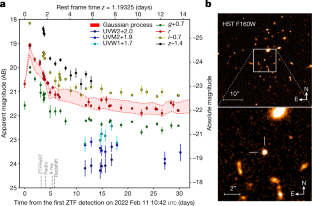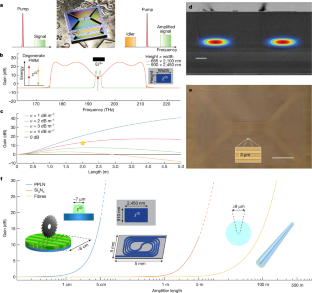死にかけの星とブラックホールの出会いによる閃光は、これまで観測された中で最も明るい光フレアの一つです Flash caused by a dying star’s encounter with a black hole is among the brightest optical flare ever observed
2022-12-01 ミネソタ大学
死にかけた星が超巨大ブラックホールに近づきすぎた場合、星はブラックホールの重力潮汐力によって激しく引き裂かれ、ブラックホールの周りを回る円盤に取り込まれ、最終的にはブラックホールに飲み込まれます。これを天文学者は潮汐破壊現象(TDE)と呼んでいる。
しかし、極めて稀なケースとして、超巨大ブラックホールが星を破壊した後に「相対論的ジェット」(光速に近い速度で進む物質のビーム)を発射することがある。研究者たちは、ズウィッキー・トランジェント・ファシリティ(ZTF)調査で、そのようなケースの1つを発見した。
AT2022cmc以前には、2つのジェットTDEが知られていましたが、これらはガンマ線宇宙探査によって発見された。このような現象は2012年に発見されたのが最後で、このような現象をさらに発見するためには、新しい方法が必要でした。そこで研究者たちは、AT2022cmc を発見するために、地上での光学的調査、つまり特定の観測目標を持たない空の全体図を描くという、新しい「大局的」戦術を採用した。カリフォルニアにあるサミュエル・オシン望遠鏡で撮影された広視野の天空測量「ZTF」を使って、研究チームはこの眠っているようなブラックホールを特定し、独自に研究することができた。
毎晩100万ページの情報に相当するZTFデータの高速解析により、相対論的ジェットを持つTDEを迅速に特定し、X線からミリ波、電波に至る電磁スペクトル全域で非常に高い輝度を持つことを明らかにする追跡観測を行うことができた。
その後、多くの天文台で観測が行われ、AT2022cmcが急速に暗くなっていくことが確認され、ESOの超大型望遠鏡により、AT2022cmcが85億光年という宇宙的距離にあることが明らかにされた。
なぜ、ジェットを放出する TDE とそうでないものがあるのかは、まだ謎のままです。今回の観測から、研究チームは、AT2022cmc や他の同じようにジェット噴射をする TDE のブラックホールは、非常に明るいジェットを発生させるために、高速で回転している可能性が高いと結論づけた。これは、何十億光年も離れた銀河の中心にある超巨大ブラックホールの物理の解明に近づく、ジェットの発射に必要な要素のひとつが、ブラックホールの高速回転である可能性を示唆するものである。
<関連情報>
- https://cse.umn.edu/college/news/researchers-spot-rare-luminous-jet-spewed-supermassive-black-hole
- https://www.nature.com/articles/s41586-022-05465-8
大質量ブラックホールによる星の崩壊で発生した非常に明るいジェット A very luminous jet from the disruption of a star by a massive black hole
Igor Andreoni,Michael W. Coughlin,Daniel A. Perley,Yuhan Yao,Wenbin Lu,S. Bradley Cenko,Harsh Kumar,Shreya Anand,Anna Y. Q. Ho,Mansi M. Kasliwal,Antonio de Ugarte Postigo,Ana Sagués-Carracedo,Steve Schulze,D. Alexander Kann,S. R. Kulkarni,Jesper Sollerman,Nial Tanvir,Armin Rest,Luca Izzo,Jean J. Somalwar,David L. Kaplan,Tomás Ahumada,G. C. Anupama,Katie Auchettl,Sudhanshu Barway,Eric C. Bellm,Varun Bhalerao,Joshua S. Bloom,Michael Bremer,Mattia Bulla,Eric Burns,Sergio Campana,Poonam Chandra,Panos Charalampopoulos,Jeff Cooke,Valerio D’Elia,Kaustav Kashyap Das,Dougal Dobie,José Feliciano Agüí Fernández,James Freeburn,Cristoffer Fremling,Suvi Gezari,Simon Goode,Matthew J. Graham,Erica Hammerstein,Viraj R. Karambelkar,Charles D. Kilpatrick,Erik C. Kool,Melanie Krips,Russ R. Laher,Giorgos Leloudas,Andrew Levan,Michael J. Lundquist,Ashish A. Mahabal,Michael S. Medford,M. Coleman Miller,Anais Möller,Kunal P. Mooley,A. J. Nayana,Guy Nir,Peter T. H. Pang,Emmy Paraskeva,Richard A. Perley,Glen Petitpas,Miika Pursiainen,Vikram Ravi,Ryan Ridden-Harper,Reed Riddle,Mickael Rigault,Antonio C. Rodriguez,Ben Rusholme,Yashvi Sharma,I. A. Smith,Robert D. Stein,Christina Thöne,Aaron Tohuvavohu,Frank Valdes,Jan van Roestel,Susanna D. Vergani,Qinan Wang & Jielai Zhang
Nature Published:30 November 2022
DOI:https://doi.org/10.1038/s41586-022-05465-8

Abstract
Tidal disruption events (TDEs) are bursts of electromagnetic energy that are released when supermassive black holes at the centres of galaxies violently disrupt a star that passes too close1. TDEs provide a window through which to study accretion onto supermassive black holes; in some rare cases, this accretion leads to launching of a relativistic jet2,3,4,5,6,7,8,9, but the necessary conditions are not fully understood. The best-studied jetted TDE so far is Swift J1644+57, which was discovered in γ-rays, but was too obscured by dust to be seen at optical wavelengths. Here we report the optical detection of AT2022cmc, a rapidly fading source at cosmological distance (redshift z = 1.19325) the unique light curve of which transitioned into a luminous plateau within days. Observations of a bright counterpart at other wavelengths, including X-ray, submillimetre and radio, supports the interpretation of AT2022cmc as a jetted TDE containing a synchrotron ‘afterglow’, probably launched by a supermassive black hole with spin greater than approximately 0.3. Using four years of Zwicky Transient Facility10 survey data, we calculate a rate of 0.02+0.04−0.01 per gigapascals cubed per year for on-axis jetted TDEs on the basis of the luminous, fast-fading red component, thus providing a measurement complementary to the rates derived from X-ray and radio observations11. Correcting for the beaming angle effects, this rate confirms that approximately 1 per cent of TDEs have relativistic jets. Optical surveys can use AT2022cmc as a prototype to unveil a population of jetted TDEs.



